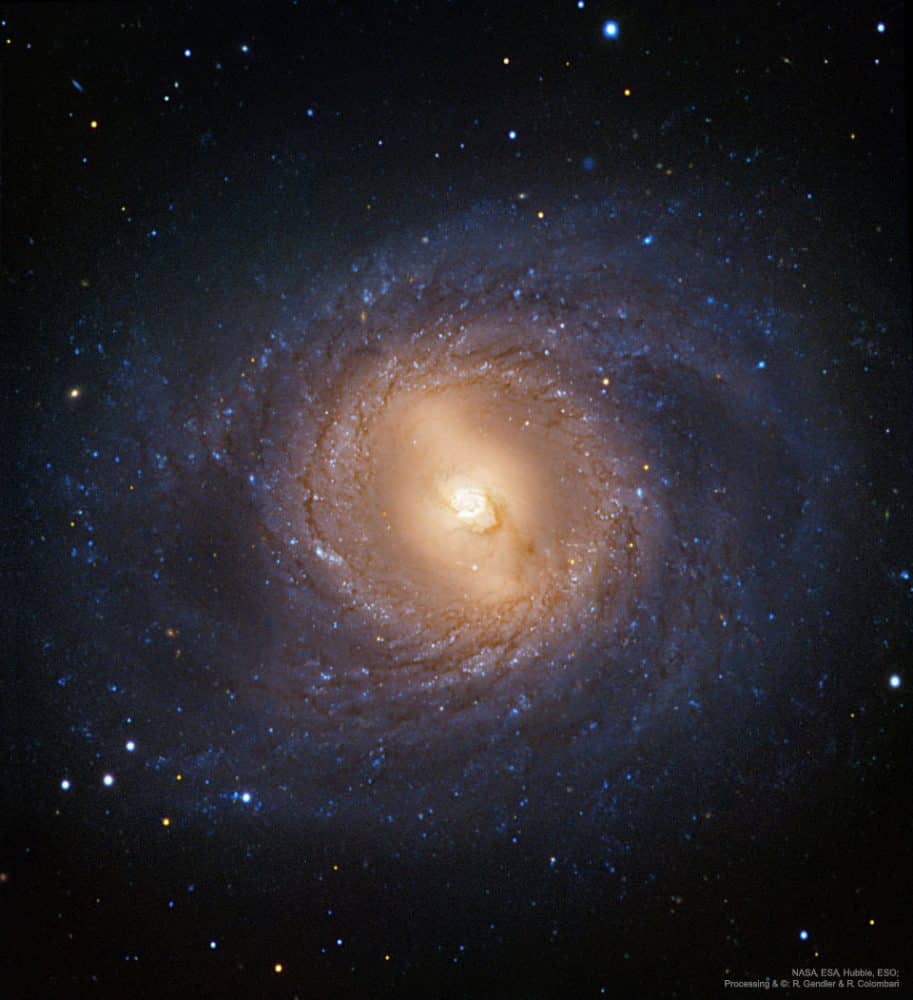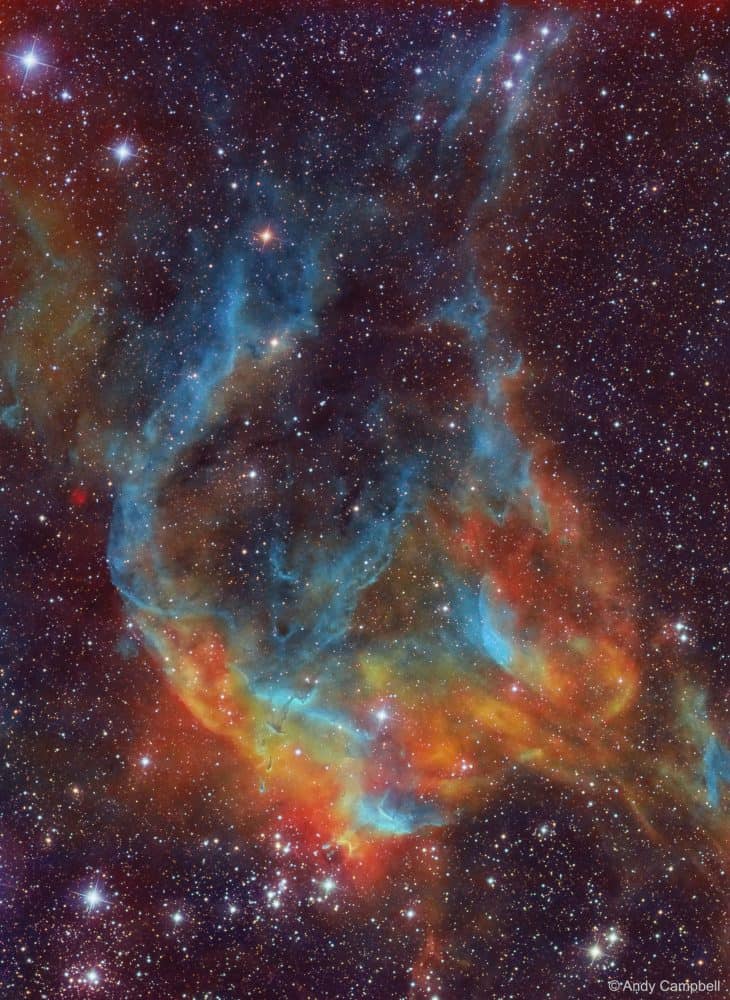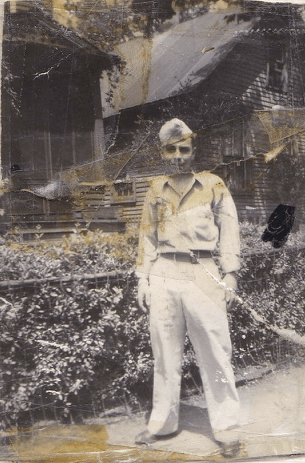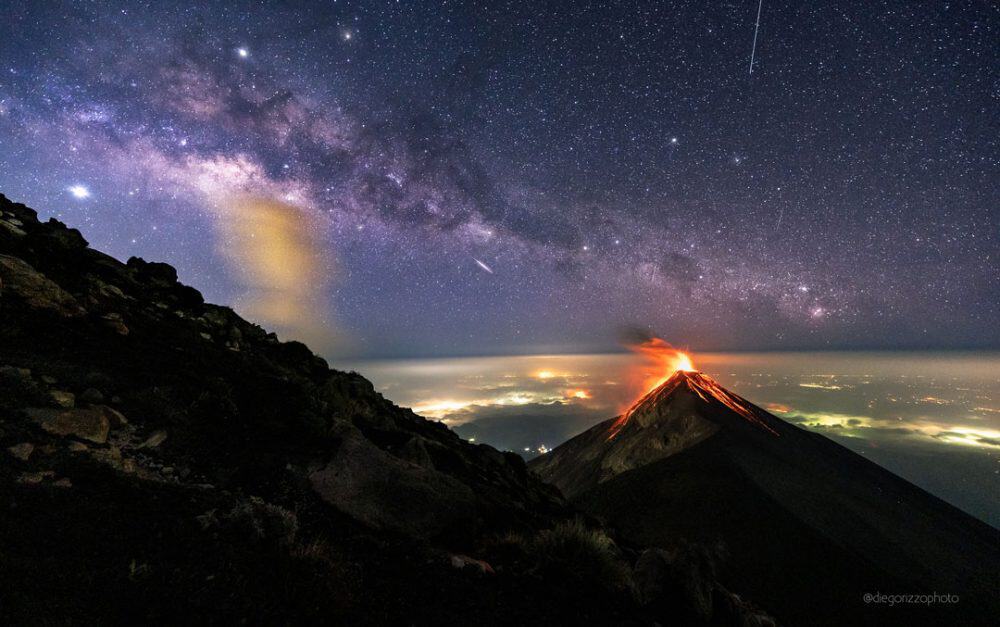Blog
First and foremost, M95 is one of the closer examples of a big and beautiful barred spiral galaxy. Visible in the featured combination of images from Hubble and several ground based telescopes are sprawling spiral arms delineated by open clusters of bright blue stars, lanes of dark dust, the diffuse glow of billions of faint stars, and a short bar across the galaxy center. What intrigues many astronomers, however, is the circumnuclear ring around the galaxy center visible just outside the central bar. Although the long term stability of this ring remains a topic of research, observations indicate its present brightness is at least enhanced by transient bursts of star formation. M95, also known as NGC 3351, spans about 50,000 light-years, lies about 30 million light years away, and can be seen with a small telescope toward the constellation of the Lion (Leo).
more...Daniel Robert Elfman (born May 29, 1953) is an American composer, singer, songwriter, and record producer. Elfman first became known for being the lead singer and songwriter for the band Oingo Boingo from 1974 to 1995. He is well known for scoring films and television shows, particularly his frequent collaborations with director Tim Burton. One of Elfman’s notable compositions is The Simpsons theme, which he wrote in 1989.
In 1976, Elfman entered the film industry as an actor. In 1980, he scored his first film, Forbidden Zone, directed by his older brother Richard Elfman. Among his honors are four Oscar nominations, a Grammy for Batman, an Emmy for Desperate Housewives, six Saturn Awards for Best Music, the 2002 Richard Kirk Award, and the Disney Legend Award.
Was born on May 29, 1953 in Los Angeles, California to a Jewish family from Poland and Russia.
more...Eugene Joseph Wright (born May 29, 1923), nicknamed The Senator, is an American jazz bassist, best known for his work as a member of The Dave Brubeck Quartet, in particular on the group’s most famous album, Time Out (1959), with pianist Brubeck, drummer Joe Morello and alto saxophonist Paul Desmond.
Wright had played with the Lonnie Simmons group, and led his own band, the Dukes of Swing, but his big break came when he was recruited by Dave Brubeck. He had a very solid, Kansas-city style, theoretically at odds with, but in practice an important component of, Brubeck’s cool, mannered jazz.
In addition to Brubeck, Wright has played with many jazz stars, including Count Basie, Charlie Parker, Billie Holiday, Carmen McRae, Buddy DeFranco, Cal Tjader, Kai Winding, Karen Hernandez, Sonny Stitt, Gene Ammons, Dottie Dodgion, Lee Shaw, Dorothy Donegan, and Monty Alexander.
Basically Wright is a book of his compositions for bass published by Hansen.
With the death of his bandleader Dave Brubeck on December 5, 2012, Wright is the only living member of the classic quartet.
more...Carl Story (May 29, 1916 – March 31, 1995) was an influential bluegrass musician and leader of his band the “Rambling Mountaineers”. He was dubbed “The Father of Bluegrass Gospel Music” by the governor of Oklahoma. Story was born in Lenoir, North Carolina into a musically inclined family. His father played the fiddle and his mother played the guitar and Story learned to master both fiddle, guitar and clawhammer banjo. In the early 1930s, after winning a fiddle contest, he joined “J. E. Clark and the Lonesome Mountaineers” performing at WLVA in Lynchburg, Virginia. In 1934, he formed the “Rambling Mountaineers” together with banjo player Johnny Whisnant and guitarists Dudley Watson and Ed McMahan. Within a year they played over radio station WHKY in Hickory, North Carolina. It later led to performances at WSPA in Spartanburg, South Carolina and WWNC in Asheville, North Carolina. They recorded for ARC in 1939 and Okeh Records in 1940; however, these recordings were never issued. Story played with Bill Monroe in 1942 as a fiddler – replacing Howdy Forrester who had been drafted – but eventually he was drafted too in October 1943.
After his discharge from the Navy in 1945, he began performing with his “Rambling Mountaineers” on the “Mid-Day Merry-Go-Round” show at WNOX in Knoxville, Tennessee. In 1947, he recorded for the Mercury label. At the recording sessions of 1947, Story temporarily labelled his band the “Melody Four Quartet”. During the 1950s, Carl Story’s “Rambling Mountaineers” performed on the “Farm and Fun Time Show” at WCYB in Bristol, Virginia and on the “Cas Walker Show” over WBIR-TV in Knoxville, Tennessee. His “Mountaineers” also appeared on radio stations WAYS in Charlotte, North Carolina, WEAS in Decatur, Georgia, and WLOS in Asheville, North Carolina. He had a new recording contract on Columbia Records in 1953. Two years later he was back to Mercury Records. In 1957, he switched label to Starday Records where he stayed for eighteen years. In 1960, Story began working as a deejay for WFLW in Monticello, Kentucky. Beginning in the 1960s, and for the next twenty years, Story toured extensively throughout the USA and Europe. He signed another recording contract with CMH Records in the mid-1970s. He settled down in Greer, South Carolina working as a deejay over WCKI in Greer.
more...This chromatic cosmic portrait features glowing gas and dark dust near some recently formed stars of NGC 3572, a little-studied star cluster near the Carina Nebula. Stars from NGC 3572 are visible near the bottom of the image, while the expansive gas cloud above is likely what remains of their formation nebula. The image‘s striking hues were created by featuring specific colors emitted by hydrogen, oxygen, and sulfur, and blending them with images recorded through broadband filters in red, green, and blue. This nebula near NGC 3572 spans about 100 light years and lies about 9,000 light years away toward the southern constellation of the Ship’s Keel (Carina). Within a few million years the pictured gas will likely disperse, while gravitational encounters will likely disperse the cluster stars over about a billion years.
more...Leland Bruce Sklar (born May 28, 1947) is an American electric bass guitarist and session musician. He is a member of the Los Angeles-based instrumental group The Section, who served as the de facto house band of Asylum Records and were one of the progenitors of the soft rock sound prevalent on top-40 radio in the 1970s and 1980s. Besides appearing as the backing band on numerous recordings by artists such as Jackson Browne, Carole King, and James Taylor, the Section also released three solo albums of instrumental rock. Both in The Section and separately, Sklar has contributed to over 2,000 albums as a session musician. He also has toured extensively with major rock and pop acts, and recorded many soundtracks to films and television shows.
Sklar studied at California State University, Northridge. It was during that time he met James Taylor, who invited him to play bass at some venues. They both thought that the work would be short-term, but soon Taylor’s career took off with his first hit records, and Sklar came into the limelight. He was soon asked to record with others, and his long career began. In the 1970s, Sklar worked so frequently with drummer Russ Kunkel, guitaristDanny Kortchmar, and keyboardist Craig Doerge that they eventually became known as “The Section” and recorded three albums under that name between 1972 and 1977.
more...
Aaron Thibeaux “T-Bone” Walker (May 28, 1910 – March 16, 1975) was an American blues guitarist, singer, songwriter and multi-instrumentalist, who was a pioneer and innovator of the jump blues and electric bluessound. In 2018 Rolling Stone magazine ranked him number 37 on its list of “The 100 Greatest Guitarists of All Time”. Walker was born in Linden, Texas, of African-American and Cherokee descent. His parents, Movelia Jimerson and Rance Walker, were both musicians. His stepfather, Marco Washington, taught him to play the guitar, ukulele, banjo, violin, mandolin, and piano.
In 1942, Charlie Glenn, the owner of the Rhumboogie Café, brought T-Bone Walker to Chicago for long-time stints in his club. In 1944 and 1945, Walker recorded for the Rhumboogie label, which was tied to the club, backed up by Marl Young‘s orchestra.
T-Bone Walker performed at the second famed Cavalcade of Jazz concert held at Wrigley Field in Los Angeles produced by Leon Hefflin Sr. on October 12, 1946. Jack McVea, Slim Gaillard, The Honeydrippers, Lionel Hampton and his Orchestra, and Louis Armstrong were all on the same program. He also performed for the third Cavalcade of Jazz concert held in the same location on September 7, 1947 along with Woody Herman as Emcee, The Valdez Orchestra, The Blenders, The Honeydrippers, Slim Gaillard, Johnny Otis and his Orchestra, Toni Harper, The 3 Blazers and Sarah Vaughn.
Much of his output was recorded from 1946 to 1948 for Black & White Records, including his most famous song, “Call It Stormy Monday (But Tuesday Is Just as Bad)” (1947). Other notable songs he recorded during this period were “Bobby Sox Blues” (a number 3 R&B hit in 1947) and “West Side Baby” (number 8 on the R&B singles chart in 1948).
Andrew Dewey Kirk (May 28, 1898 – December 11, 1992) was a jazz saxophonist and tubist who led the Twelve Clouds of Joy, a band popular during the swing era.
Kirk grew up in Denver, Colorado, where he was tutored by Wilberforce Whiteman, Paul Whiteman’s father.Kirk started his musical career playing with George Morrison’s band, but then went on to join Terrence Holder‘s Dark Clouds of Joy. In 1929 he was elected leader after Holder departed. Renaming the band Clouds of Joy, Kirk also relocated the band from Dallas, Texas, to Kansas City, Missouri. Although named the Clouds of Joy, the band has also been known as the Twelve Clouds of Joy due to the number of musicians in the band. They set up in the Pla-Mor Ballroom on the junction of 32nd and Main in Kansas City and made their first recording for Brunswick Records that same year. Mary Lou Williams came in as pianist at the last moment, but she impressed Brunswick’s Dave Kapp, so she became a member of the band.
Kirk moved the band to Kansas City, and since their first recordings in 1929–1930, they grew popular as they epitomized the Kansas City jazz sound. In mid-1936, he was signed to Decca and made scores of popular records until 1946.
https://www.youtube.com/watch?v=lF_o8O4ANL4
more...https://www.youtube.com/watch?v=ZXLEBzdpdF0
more...https://www.youtube.com/watch?v=KQPyk4OUkeA&list=PLEB3LPVcGcWZ0hsQ5_jgSMhawAnDzy1io&index=2&t=0s
more...My dad Mike LaBriola as a teenager and soldier during WWII. He was stationed in Italy his place of birth. Now fighting the Nazi/Mussolini occupation as an American soldier. Pictured here in Blue Island, Ill
more...Volcan de Fuego is an active stratovolcano in Guatemala, on the borders of Chimaltenango, Escuintla and Sacatepéquez departments. It sits about 16 kilometres (9.9 mi) west of Antigua, On the land of the featured image, for example, the Volcano of Fire (Volcán de Fuego) is seen erupting topped by red-hot, wind-blown ash and with streams of glowing lava running down its side. Lights from neighboring towns are seen through a thin haze below. In the sky, though, the central plane of our Milky Way Galaxy runs diagonally from the upper left, with a fleeting meteor just below, and the trail of a satellite to the upper right. The planet Jupiter also appears toward the upper left, with the bright star Antares just to its right. Much of the land and the sky were captured together in a single, well-timed, 25-second exposure taken in mid-April from the side of Fuego‘s sister volcano Acatenango in Guatemala. The image of the meteor, though, was captured in a similar frame taken about 30 minutes earlier — when the volanic eruption was not as photogenic — and added later digitally.
more...Dee Dee Bridgewater (née Denise Garrett, May 27, 1950) is an American jazz singer. She is a three-time Grammy Award-winning singer-songwriter, as well as a Tony Award-winning stage actress. For 23 years, she was the host of National Public Radio’s syndicated radio show JazzSet with Dee Dee Bridgewater. She is a United Nations Goodwill Ambassador for the Food and Agriculture Organization.
Born Denise Eileen Garrett in Memphis, Tennessee, she was raised Catholic in Flint, Michigan. Her father, Matthew Garrett, was a jazz trumpeter and teacher at Manassas High School, and through his playing, she was exposed to jazz early on. At the age of sixteen, she was a member of a Rock and Rhythm ‘n’ Blues trio, singing in clubs in Michigan. At 18, she studied at Michigan State University before she went to the University of Illinois at Urbana-Champaign. With the school’s jazz band, she toured the Soviet Union in 1969.
The next year, she met trumpeter Cecil Bridgewater, and after their marriage, they moved to New York City, where Cecil played in Horace Silver‘s band. In the early 1970s, Bridgewater joined the Thad Jones-Mel Lewis Jazz Orchestra as lead vocalist. This marked the beginning of her jazz career, and she performed with many of the great jazz musicians of the time, such as Sonny Rollins, Dizzy Gillespie, Dexter Gordon, Max Roach, Rahsaan Roland Kirk and others. She performed at the Monterey Jazz Festival in 1973. In 1974, her first solo album, entitled Afro Blue, appeared, and she performed on Broadway in the musical The Wiz. For her role as Glinda the Good Witch she won a Tony Award in 1975 as “Best Featured Actress”, and the musical also won the 1976 Grammy Award for Best Musical Show Album.
more...Niels-Henning Ørsted Pedersen (Danish pronunciation: [nelsˈhɛneŋ ˈɶɐ̯stəð ˈpʰɛðɐsn̩], 27 May 1946 – 19 April 2005), often known as NHØP, was a Danish jazz upright bassist known for his technique and musical approach.
Ørsted Pedersen was born in Osted, near Roskilde, on the Danish island of Zealand, the son of a church organist. As a child, Ørsted Pedersen played piano, but from the age of 13, he started learning to play upright bass and at the age of 14, while studying, he began his professional jazz career in Denmark with his first band, Jazzkvintet 60 (Danish for Jazz Quintet 60). By the age of fifteen, he had the ability to accompany leading musicians at nightclubs, working regularly at Copenhagen’s Jazzhus Montmartre, after his debut there on New Year’s Eve 1961, when he was only 15. When seventeen, he had already turned down an offer to join the Count Basie orchestra, mainly because he was too young to get legal permission to live and work as a musician in the United States.
The Montmartre was a regular stop-off for touring American Jazz stars, and as a member of the house band, the young Ørsted Pedersen performed with saxophonists such as Sonny Rollins, Dexter Gordon, Rahsaan Roland Kirk and Stan Getz, and pianist Bill Evans, with whom he toured in Europe in 1965. During the 1960s, Ørsted Pedersen played with a series of other important American jazzmen who were touring or resident in Denmark, including Ben Webster, Brew Moore, Bud Powell, Count Basie, Roy Eldridge, Dizzy Gillespie, Jackie McLean, and vocalist Ella Fitzgerald. He also played with Jean-Luc Ponty, and became the bassist of choice whenever a big-name musician was touring Copenhagen.
https://www.youtube.com/watch?v=vZrQIn23018
more...Clifford Everett “Bud” Shank, Jr. (May 27, 1926 – April 2, 2009) was an American alto saxophonist and flautist. He rose to prominence in the early 1950s playing lead alto and flute in Stan Kenton‘s Innovations in Modern Music Orchestra and throughout the decade worked in various small jazz combos. He spent the 1960s as a first-call studio musician in Hollywood. In the 1970s and 1980s, he performed regularly with the L. A. Four. Shank ultimately abandoned the flute to focus exclusively on playing jazz on the alto saxophone. He also recorded on tenor and baritone sax. He is also well known for the alto flute solo on the song “California Dreamin’” recorded by The Mamas & the Papas in 1965.
Bud Shank was born in Dayton, Ohio. He began with clarinet in Vandalia, Ohio, but had switched to saxophone before attending the University of North Carolina. While at UNC, Shank was initiated into the Pi Kappa Alpha Fraternity. In 1946 he worked with Charlie Barnet before moving on to Kenton and the West coast jazz scene. He also had a strong interest in what might now be termed world music, playing Brazilian-influenced jazz with Laurindo Almeida in 1953–54.
more...More Posts
- Milo Fine: Composing in Real Time
- Homewood Studios: You Do Not Have to Leave the Community to Find Great Art
- David Harris: Music Builds Community
- Jamie Carter: Music is a Reflection of Life
- Merlin Brunkow-Bronco Keeps on Playing
- Scott Nieman-Music Brings People Together Locally and Globally
- KARIBUNI
- Maqam
- Ancestor Energy
- Maroons
- Mojo Roots
- Voices of Sepharad
- Beau Koo Jacks
- World Cafe International
- Mojo Roots: Prakriti’s Kiss
- Ancestor Energy: Allwhere
- Songs for Diego: I’m Missing You



